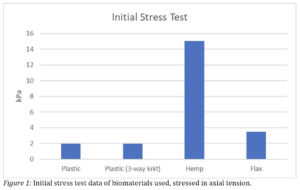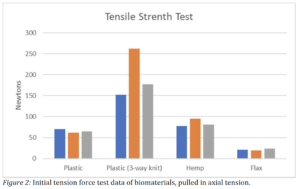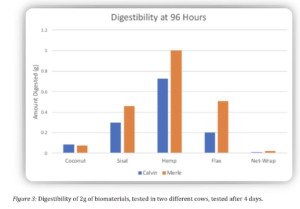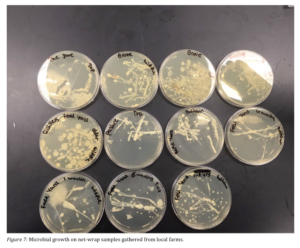Final report for FNC18-1131
Project Information
The Konechne Ranch has been an integral part of the small local community of Kimball for 70 years over 3 generations. It is a family oriented business that is supervised by Chris, his brother, and father. We raise 2,000 head of cattle on our ranch every year. We have approximately 850 acres of corn grown for cattle feed, and many more acres of forage that we grow for feed and our hunting lodge business. We manage over 5,000 acres of continuous land. We buy and sell livestock through our local livestock auction. We contribute to our local and regional areas by purchasing feed and equipment locally, as well as help neighbors whenever necessary.
Net wrap is the method of binding round hay bales to store for livestock production. It helps maintain storage quality over a period of time; however, there’s a problem. Net wrap poses health risks to livestock, unneeded environmental waste, and added machinery maintenance.
The net wrap is used worldwide, because it has increased water shedding ability and decreased storage losses or wasted feed. Here’s the problem: A large percentage of ranchers do not remove net wrap as recommended per vets and ag extension agents for time, cost and labor reasons. The net wrap is ground into smaller particles for feed, and not removed. Therefore, small pieces of plastic are mixed in with other feed ingredients. This plastic can get trapped in the digestive system and decrease feed efficiency and even lead to health problems or death. This plastic is not digestible, so once it is consumed, it can start to accumulate in the digestive system of livestock. If the net wrap is removed from the bale before feeding, it must be removed from any possibility that the animal may chew on the discarded wrap. In the circumstance that a livestock animal dies from net wrap accumulation, it becomes a financial loss for the rancher, especially if there was added cost to treat the animal with antibiotics or vet assistance.
Identifying the amount of net wrap used annually, and the benefits of providing a digestible replacement for plastic net wrap that poses no health risk to their long-term life cycle includes the following advantages:
- Reducing manual labor, and time to cut net wrap off and excess plastic waste for the rancher.
- Reducing the financial stress due to livestock death loss.
- Reducing maintenance on machinery.
- Removing all plastic particles mixed into feed ingredients.
- Reducing the amount of non-digested matter in manure spread into fields.
- Reducing the plastic waste added to our environment.
Our team research has narrowed down the natural materials to be used and are focusing on how the preservation of these factors comes into play with the strength and durability. This product would change how we view the nutritional benefit of our livestock. It has major potential to become natural and healthy for livestock production and benefits the rancher in long-term financial security with less death loss percentage.
In a movement to try and solve this issue for ranchers, we seek to answer questions about the impact net wrap can have on the daily operation of a ranch. The material research, strength and temperature testing, and prototype production can determine the outcomes of what the success of this idea can mean for the whole industry. It will reduce the negative impact of forage binding materials on livestock health and longevity.
Universities that provide agricultural-related curriculum help organizations like the South Dakota State University (SDSU) Extension advise producers on good livestock management practices. The vision of SDSU Extension is to provide outreach, solutions and create opportunities for our citizens. Amanda reached out to a local SDSU Extension agent with this problem and her research, and started looking for solutions to getting laboratory work going. Amanda’s research was seeking information from researchers and other universities, and it appeared that there was no specific product commercially available to eliminate the net wrap consumption problem, besides manually removing it from bales prior to feeding.
The Jack Wrap-it Project is a collaboration with SDSU senior Ag and Bio-engineering students, who are looking for an alternative to net wrap. The students’ research will be able to identify the impact to the ranch operation, as well as to the environment, by establishing product durability, functionality and cost effectiveness of the production and use of the Jack Wrap-it.
This idea addresses the challenge faced by producers across the Midwest and U.S. and provides the livestock industry with an estimate of livestock at risk, an estimate of the impact of reduced performance (reduced cost-to gain ratio) that occurs from net wrap accumulation.
The Jack Wrap-it Project achieves two objectives: (1) surveying livestock resources to determine the risk and incidence of net wrap ingestion by livestock and (2) developing a sustainable forage binding product that withstands environmental elements yet is health friendly for livestock. Achieving these two objectives will prepare the way for the next steps in the Jack Wrap-it Project, which is to determine cost-effective production in the U.S., and introduction to agriculture markets.
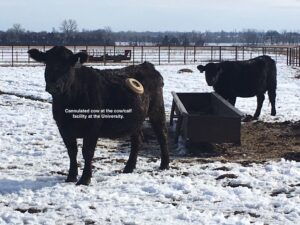

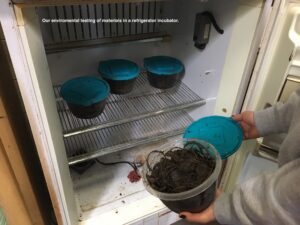
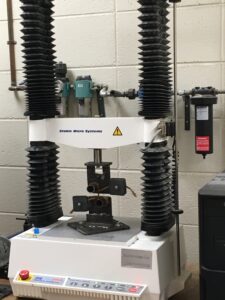

There are 3 main considerations with this project overall, finding materials that have passed the testing methods that utilize product durability, functionality, and cost effectiveness. The following are steps that we are taking to develop this new product:
- Durability. Finding materials or a mixture of materials that can withstand the force of a round bale and the elements exposed to the material. To ease the flow of production, the product will follow similar guidelines of the current net wrap manufacturing process. End product is durable to the weather elements and has enough strength from farm activities after being stored for 12 to 18 months.
- Functionality. The developed material is digestible and has no negative effect on the livestock animals that can include a forage wrap material in their nutrition plan. Natural materials will be the focus on the wrap being used. The end product does not present internal harm to livestock.
- Cost Effective. Developing a cost-effective product. Average cost per plastic wrapped bale is $1.25-$1.45 and a whole roll cost on average costs $225. It is detrimental to stay within the same perimeters of cost for the rancher. (Average approximately 150-170 wrapped bales per roll.)
Cooperators
- (Researcher)
- (Researcher)
- (Researcher)
- (Researcher)
- (Researcher)
- (Educator)
- (Educator)
Research
Along with SDSU extension, we provided an outreach outlet consisting of an online research and needs assessment survey on the usage of net wrap. We wanted to receive feedback on the usage and the support behind an edible net wrap. The extension agent and I met to come up with the questions we wanted to ask in reference to net wrap usage and accumulation. Some of the questions we asked were: 1. What binding method do you use for baled forage? 2. What is your primary feeding method of baled forage? 3. Do you remove the binding material before you feed it to livestock? 3. Do you have a veterinarian conduct a postmortem exam when livestock deaths occur?
We wanted to get the numbers and support behind this diverse product that we are trying to develop as we feel it is a huge need in our ranching communities and will change the face of how we care for our livestock. In addition to this, the decision to have this additional research will help for future marketing and business plans in building a great product platform.
By using an online forum, we were able to put our results into percentage quickly for analysis. We found that 80% of our surveyors were beef cow/calf producers and out of that more than 67% use net wrap. According to the total amount of surveyors, 86% said they would find great benefit to an edible net wrap in their feeding practices. 80% agreed that net wrap poses health risks to their livestock. 50% said they have observed internal net wrap accumulation via a postmortem exam of the livestock and 44% of that observed was in mature cows.
Once edible net wrap is on the market, it will start to eliminate the conventional plastic net wrap because of the natural make-up and benefits to having it in an every day feeding practice. It will cut producers time in half and eliminate the need to cut the net wrap off. Current net wrap procedure is to cut the plastic off, which only provides unwanted waste that either needs to be burned, disposed of in a dump, or picked up by a rendering service, which in turn costs more money to the producer.
Based on our simple calculations of net wrap waste in the U.S., the numbers are as follows:
Approximately 120,000,000 bales are consumed nationally every year.
That is 18 ft of plastic per wrap x 2.5 wraps = 45 ft per bale
45 ft x 120 million bales = 5.4 billion feet of net wrap used each year
5.4 billion ft is equivalent to the length of 15 million football fields.
5.4 billion feet / average length of net wrap roll, 7000 ft per roll = 771,429 rolls of net wrap used each year
771,429 rolls x 161 lbs per roll = 1.2 million lbs of net wrap waste each year
771,429 rolls x average $225 per roll = $173 million+ in net wrap used each year
Based on analysis done by the university students, we have moved into the next phase which is finding and collaborating with product sources and manufacturing to produce a prototype. SDSU is not collaborating with us in the 2019-2020 year, but we've been in discussion about contracted help in the future in regards to marketing the product.
The veterinarian needs assessment presented results from vets from SD, MN, IA and ND. Vets that observed net wrap accumulation in livestock, documented that it was found mostly in mature or dairy cows, as well as commonly found in sheep. Common issues among the animals were decreased feeding or off feed resulting in bloating and/or sudden acute death. Most of surveyors rated this issue somewhat or very critical.SARE
Per additional research on normal pH for cows, corn makes this unnaturally acidic if there is not enough roughage in the diet. This can lead to cattle off their feet or pant, resulting in conditions that can lead to many complications, such as, bloat, ulcers, liver disease, and general weakening of the immune system. Additionally, if there is net wrap accumulation in the rumen, poses other or similar complications in nature to the cow. The roughage is important to balance out, and with an edible net wrap, would help the rancher sustain better overall health in their cattle.
There have been 3 more new connections in 2020-2021.
1. USA based manufacturer that may be able to help produce a prototype, hopefully eliminating shipping costs overseas. The discussion is set on what manufacturing processes are being used in the facility, so that it can be determined whether or not the materials fit into the criteria.
2. Discussion with 2 individuals in Argentina, one that has access to tannins, and the other a possible hemp resource. The project was discussed over email and Zoom about the opportunities available to further the project. The purchasing of materials should not be an issue, but is on hold until the processes of the manufacturing is understood.
On-Ranch post mortem, January 19, 2021
Ill cow that had been treated, unknown death but suspected net wrap accumulation to be the culprit. An order for a local vet to perform a post mortem examination was placed, with the post happening in January of 2021. Unfortunately, the post showed no results.
Educational & Outreach Activities
Participation Summary:
The awareness of net wrap accumulation in livestock is getting some wide discussion from producers, and many articles have been published about it. Some of the publications are Beef Magazine, AgWeek, iGrow, and Farm Forum. Some of the articles have been written by the SDSU Extension agent working with me on the project. The Daily Republic in Mitchell, SD and AgWeek both picked up an article for this project and we've had many producers acknowledge the need for an alternative to net wrap.
https://www.mitchellrepublic.com/business/agriculture/4431673-wrapping-better-approach-kimball
The SDSU Extension and I have also put together a QuestionPro survey for producers and vets, along with a postcard for vets to report on incidences of net wrap accumulation. We had about 400 complete the survey. Producers currently spend $1.25 to $1.45 per bale, but according to our research, 67% of surveyed producers are willing to spend $.10 to $.80 more per bale for a natural, digestible product that reduces manual labor, as well as the inconvenience of cutting the net wrap off. From the same surveyed producers, 46% said they have seen their livestock chewing and/or eating the remnants on the ground. The results of post-mortem exams on their livestock showed about 50% observed internal net wrap accumulation and 40% of the time being the lead cause of death. Eighty percent felt net wrap poses health risks to livestock and 86% would show interest in a digestible net wrap.
- 54 percent - remove net wrap or twine before feeding whole bales (in bale feeder or on the ground)
- 11 percent - remove net wrap or twine prior to grinding or processing bales
- 24 percent - do not remove net wrap or twine prior to feeding whole bales or processing bales
- 11 percent - sometimes remove binding material before feeding bales to livestock
The students in year 2017-2018 presented results at their senior expo. Those images have been posted in the overall report. This year's senior expo report is posted here.
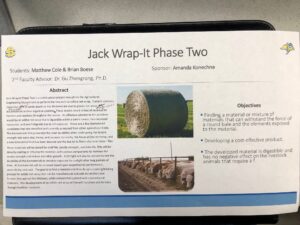
Vet Net Wrap Needs Assessment Analysis: 18 veterinarians completed survey
• 77% of vets believe net wrap poses a health risk, while 11% didn't think so. Remaining were unsure.
• 72% have observed bale wrap accumulation in livestock
• Majority observed wrap accumulations in yearlings/fed cattle and mature cows, with sheep and dairy cows following
• Majority of vets said net wrap as main cause of death happened 50% of the time, while close behind that was 25% of the time
• Common clinical signs: bloat, sudden death, blockage, difficulty swallowing, inappetence, salivation, low rumen motility
• Additional post-mortem findings: jejunal torsion, feet entangled, weight loss, peritonitis, wasting away
• 61% of vets rated this as somewhat critical animal health issue, while 16% very critical and another 16% not critical
• 61% of the vets have practiced for more than 20+ years
• Average herd size of their clients: 66% were 100+ head
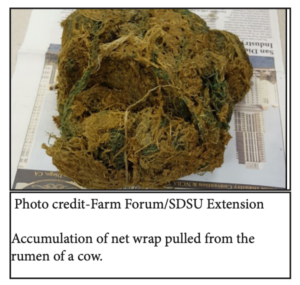

Learning Outcomes
Jack-Wrap-it-expo-presentation 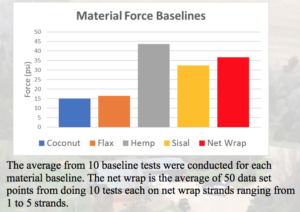
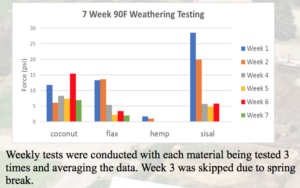
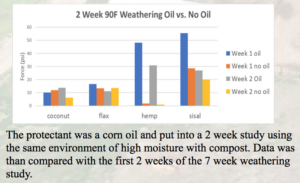
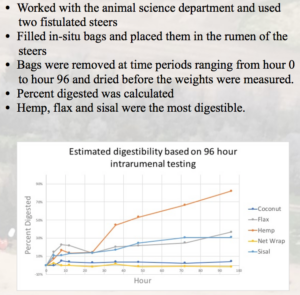
April 2018: Presentation at the SDSU Ag and Bio Engineering Senior Expo created the attached media results of the strength, environmental, and digestibility results of the current project.
The research and lab testing continues through the 2018-2019 school year with a projection of a prototype produced by April. Some mechanical and biological properties have been tested, which have been shown to be comparable with the plastic. If more material is used, then the strength can be that of the plastic net-wrap or made to be even stronger. The storability of the material is still being evaluated, due to time constraints and will continue likely into the spring. This also includes extracting and obtaining organic phytochemicals that will be used to meet the storability goal of the project.
April 2019: When researching products to use in the development of digestible net wrap, materials that excel in harsh conditions, have a reputation of being strong and durable, and are easily attainable were things that were highly considered. Our materials chosen have similar characteristics in their strength and durability.
Testing the preservation of the edible net-wrap was done with sugars and starches. Adding the proper amount, not too much, not too little, can inhibit microbes from growing while keeping the nutrients in the net-wrap. The sugar that was used for the preservation of the edible net wrap was a syrup that was extracted during intermittent sugar processing. This syrup can be applied more easily and allowed to solidify before being used for various testing.
Testing continued through the 2018-2019 year with instron for strain testing, UV-lighting, cattle rumen simulation, and weathering simulation. Samples taken from the Konechne Ranch were also analyzed to determine what kind of microbial growth there is and how to deter growth from natural fibers. The biggest factors that will degrade this product are exposure to UV light, heat, and humidity. Having a coating to prevent this will extend the life of the product and allow bales to sit longer. This coating should also inhibit microbes from growing, this way the baled foliage can keep its quality and nutrition before being fed to cattle. Being compatible with the rumen to allow the product to be digestible, without killing off rumen bacteria, will also be a future challenge for finding a UV and microbe resistant coating.
Research and partnership search continues through even now in 2021, even though the process seems to slow down from time to time. The project has focused on making connections to get a prototype built, the overall goal being a USA produced prototype. The project has seen some declines from companies that produce agricultural products, but don't show much interest in the net wrap idea, while others do show interest and direct me to research and development executives to hopefully help the process along. The resources needed have led to consultations with individuals and companies as far south as Argentina and as far north as Canada. Each step has produced new leads and ideas to make the net wrap prototype a possible reality. The most recent connections have been within the home state of South Dakota with the South Dakota Farmers Union. By discussing the overall goal of the net wrap and the needs, this project was directed to a well known engineer in Montana that is familiar with the material that is need to process and produce a prototype. Unfortunately, to seek a progressive and willing company has deemed difficult as they may show interest, but then forget. Each obstacle only makes the project thrive to find the "right fit" to such a concept worthy of helping ranchers thrive in their business practices.
Project Outcomes
With the Jack Wrap-it, producers could be assured that the estimated $173 million (basic calculation of amount spent on consumed net wrap in the U.S.) could enhance their feeding practice instead of contributing to plastic waste. Often the question from ranchers and net wrap sales representatives is “When will an edible wrap be available?” Every rancher knows the net wrap may possibly be ingested, especially if the net wrap is ground up instead of removed. The Jack Wrap-it would be a huge step in efforts to improve profitability and sustaining a healthy herd and environment.
The recommendations for net wrap is to remove it completely. For a small ranch, that may feasible to do. However, for bigger ranches, like ours, we would have to hire another farm hand to just remove net wrap, since we use approximately 5,000 bales a year. It's not as accessible of an opportunity as many may believe, therefore many producers don't cut it off.
Our product wouldn't need to be cut off, but could be used in the feed practices. Therefore, resulting in better time management, feed practices, and animal production.
